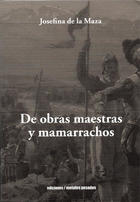During the nineteenth century, they had to adapt to the demand to become "masterpieces" and to "register" at the regional and world level, a question that produced strange solutions, unhappy grandiose effects or happy interruption of conventions (...) Josefina de la Maza finds an unprecedented point of anchoring in the notion of mamarracho, an interpretative category that incorporates an air of time to the treatment of its object and that, although it emerges from the Chilean scope, it is productive to think also nineteenth-century Latin American painting, and even more, "bad" art in contexts called peripheral or postcolonial. -Ana Marí Risk.
All book titles by this author
|
Title |
Price | ||
|---|---|---|---|
|
|
De obras maestras y mamarrachos Author: Josefina de la Maza Publisher: Ediciones Metales pesados |
$385.00 |
Shopping cart
Loading cart
Important notices
|
|
Recordando a André Rouillé: Su legado en la fotografía André Rouillé 1948 - 2025 |
|
|
Libros de filosofía y co. Disponibles en Librería Herder |
|
|
Revista Filosofía & Co. nº 9 Nueva revista de filosofia divulgativa y actualidad |
|
|
"Espacios de la filosofía" - Mauricio Beuchot - Novedad Herder México |
|
|
Revista Filosofía & Co. nº 8 Nueva revista de filosofia divulgativa y actualidad |
Pay safely with:


In the webshop
New
|
|
Cantan los ángeles, rugen los monstruos 69202 $510.00 -0.00% $510.00 |
|
|
La jurisprudencia de los cuerpos 69200 $530.00 -20.00% $424.00 |
|
|
Exasperación de la filosofía. Tomo I 68198 $450.00 -20.00% $360.00 |
|
|
El puente donde habitan las mariposas 69902 $630.00 -0.00% $630.00 |
|
|
La naturaleza contra el capital 69898 $570.00 -0.00% $570.00 |
In the press
Promotions
|
|
Diccionario técnico francés-español 20273 $3,620.00 -85.00% $543.00 |
|
|
Diccionario de la técnica industrial. Inglés-Español. Tomo I 20234 $4,835.00 -85.00% $725.25 |
|
|
Diccionario técnico español-francés 20272 $3,620.00 -85.00% $543.00 |
|
|
Diccionario de la técnica industrial. Español-Inglés. Tomo II 20233 $4,635.00 -85.00% $695.25 |
|
|
Diccionario de la técnica industrial. Español-Alemán. Tomo II 20231 $3,985.00 -85.00% $597.75 |





